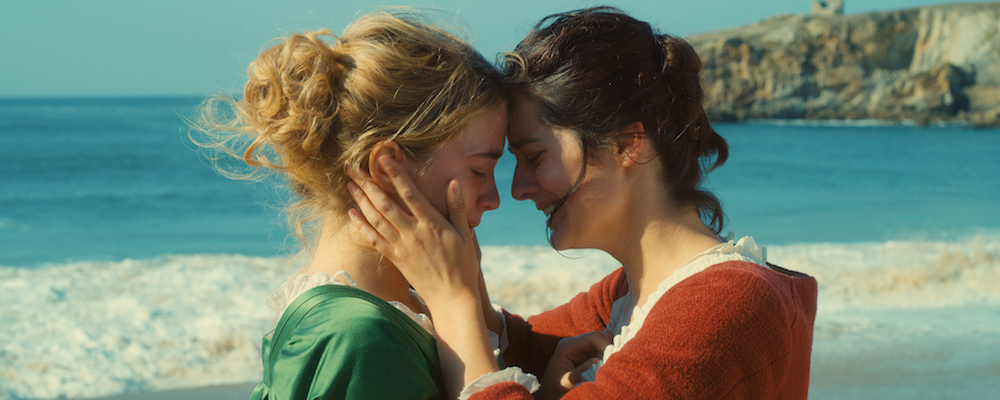‘Portrait of a Lady on Fire’ Paints an Erotic Myth of Longing and First Love
Andrew Bundy
For true love, many would run next to any kind of fool’s errand, but what if such romance is out of reach, like a fairytale dream. Present before your very eyes, the swelling feelings become immortalized, the burning desire morphing into an almost mythological fire. Your love seems meant to be, but to actually hold it in your hands is not something the world sees as acceptable.
Céline Sciamma’s “Portrait of a Lady on Fire,” which was bestowed with both Best Screenplay and Queer Palm honors at this past Cannes Film Festival, opens on a literal blank canvas before painting an authentic myth of first love through a romantic chase of fleeting memory fragments, capturing the discovery of vulnerable connection through expression incarnate. The script is certainly deserving of the accolades it has received, but the standout strength of the emotionally shattering period piece is how the film’s language is masterfully used to covey the discovery of a true connection between the two characters at the center of its beating heart, exploring how the creation of this connection inspires a framed relic of everlasting feeling, in which the sensations transposed transcend time and space.
Set in 1760 Brittany, France, a young artist named Marianne (Noémie Merlant) is hired to paint the wedding portrait of a woman named Héloïse, who is to be married off to a suitor against her wishes. Héloïse (Adèle Haenel) has previously been combative when it comes time to model for painters, and Marianne is instructed to observe her physical details in secret, posing as but a newly arrived servant during the day, working on the portrait in secret.
Commissioned to gaze upon a woman in which she soon develops a deep bond with, the work comes to represent Marianne’s very desire to please Héloïse as she is accidentally given the means to fall in love for the first time. Héloïse seems to reciprocate her feelings, but obviously cannot be outspoken about it. Soon, she agrees to pose for Marianne, allowing the two women the perfect excuse to spend more time together, but the closer the portrait comes to being completed, the sooner their blossoming tether will be torn asunder.
There are few extraneous characters and very little plot in “Portrait of a Lady on Fire,” which is first and foremost reliant on an intimate aesthetic that eventually combusts into a fervent inferno of feelings (as the title suggests). The audience is meant to absorb the raw emotions coming through the screen as if they were standing inside an art gallery, rather than try and deduce where the story is headed — a destination that is inevitably foreshadowed with its outspoken parallels to the Greek tragedy of Orpheus and Eurydice. ‘Portrait’ is the polar opposite of an exploitative, male-gaze viewpoint driven LGBTQ+ film like “Blue is the Warmest Color,” which is both incredibly refreshing and also feels long overdue.
Sciamma implements a seemingly endless sea of artistic possibilities provided by her camera lens — point of view tricks, shifts in perspective, and soft focus racks — techniques that frequently evoke the feeling of a candlelight ghost story, reflecting on the historical erasure of specific experiences from collective memory. As impeccably and impressively made as the film is, it’s the power of Merlant and Haenel’s transcendent performances which drive the heartbreaking stake home. Chemistry is never a word that even comes to question as the viewer bears witness to one of the most believable, romantic, and realistic relationship inceptions ever committed to screen — canvas, silver, or otherwise — all the while knowing the forbidden love story is destined to evaporate into a cloud of smoke.
France allotted to submit “Les Misérables” as their Best International Feature Contender for the upcoming ceremony and many critics and Oscar pundits were left scratching their heads. Cut out of the race due to the ludicrous one entry per nation rule, “Portrait of a Lady on Fire’s” reception has been so universally rapturous that it’s U.S. wide release has now been delayed until Valentine’s Day 2020, taking advantage of a loophole which will allow it to qualify for next year’s Academy Awards. It’s also a great way to let the film pick up more steam during the upcoming awards season to raise awareness.
When artistic pronouncement brings out truly lived-in emotions in the form of physical expression, such work is a timeless treasure. If the world gives you no choice in who you are allowed to love, turning back around to make sure that person is still standing behind you may not be a choice at all; you’d risk jumping out of a boat in the middle of a sea of crashing waves, drowning in their name, if you had to. One can hang such feelings on a museum wall, and maybe, now, they feel like they don’t belong to you, but the moments shared aren’t going anywhere. They live within a page of the heart’s story, and they always will. One can act like longing will disappear when refusing to turn back to stare upon an old desire, but some memories never fully fade, and some forms of love needs no painting to be immortalized.
“Portrait of a Lady on Fire” opens Dec. 6 in select theaters for a one-week engagement, and opens Feb. 14, 2020 nationwide.

